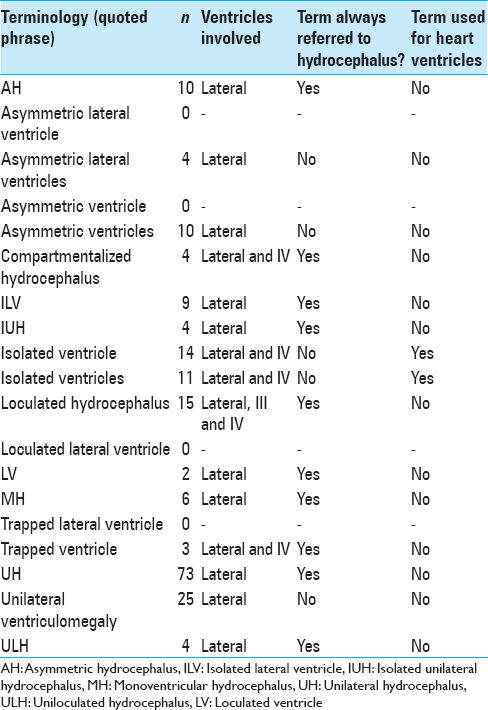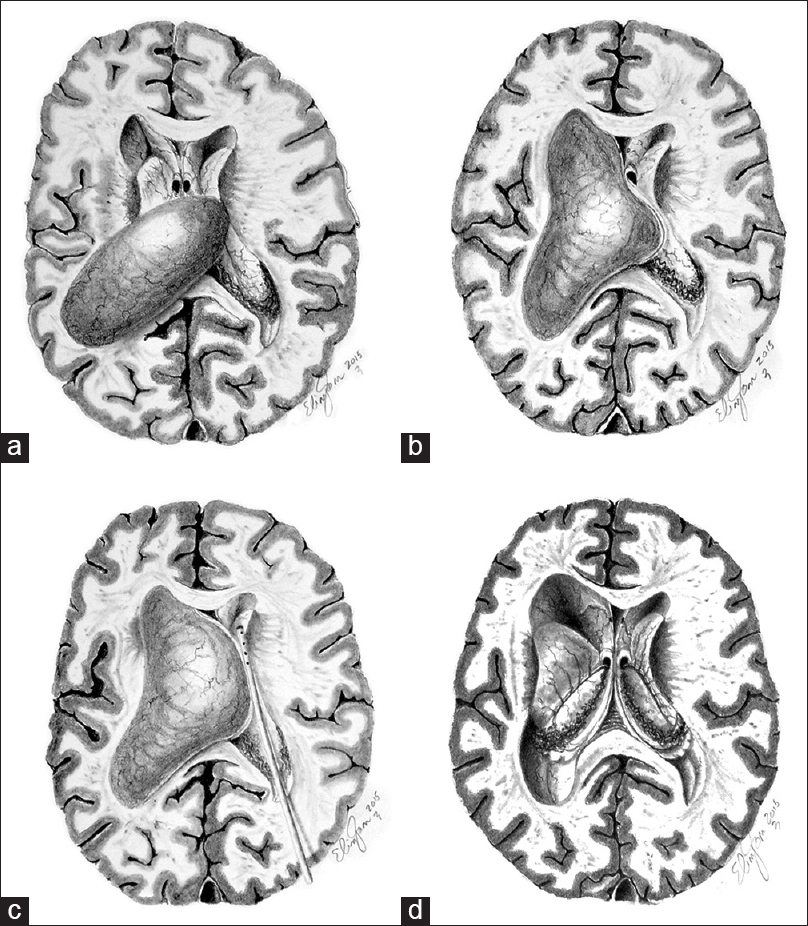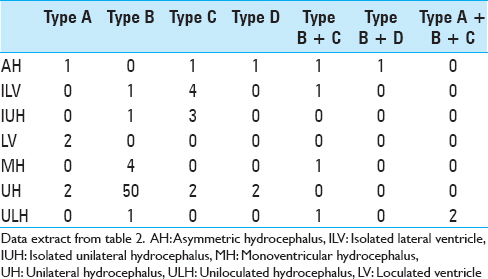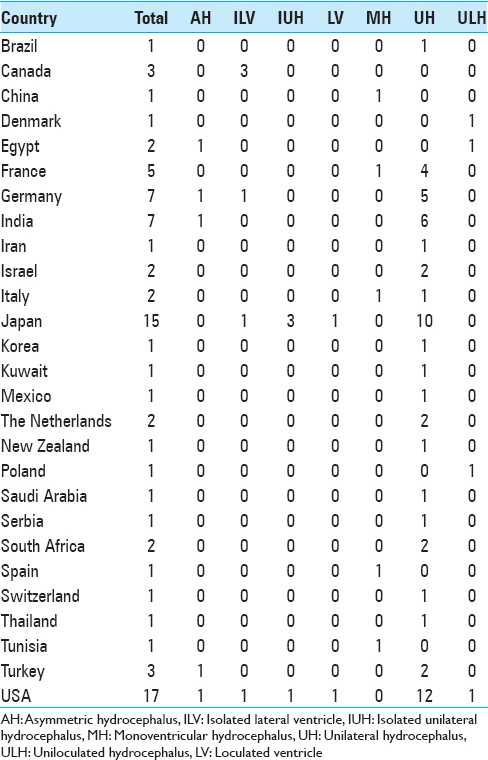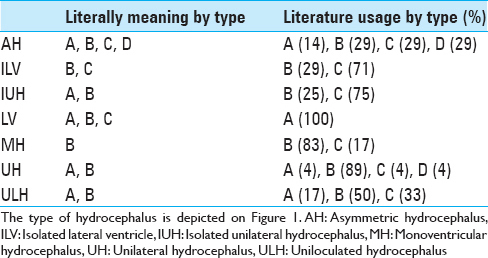- Department of Surgical Specialties, Neurosurgery Teaching and Assistance Unit, Pedro Ernesto University Hospital, Rio de Janeiro State University, Rio de Janeiro, RJ, Brazil
- Nervous System Electric Stimulation Laboratory (LabEEL) – Neurosurgery Teaching and Assistance Unit, Pedro Ernesto University Hospital, Rio de Janeiro State University, Rio de Janeiro, RJ, Brazil
- Physiological Sciences Department, Roberto Alcântara Gomes Biology Institute, Rio de Janeiro State University, Rio de Janeiro, RJ, Brazil
Correspondence Address:
Flavio Nigri
Nervous System Electric Stimulation Laboratory (LabEEL) – Neurosurgery Teaching and Assistance Unit, Pedro Ernesto University Hospital, Rio de Janeiro State University, Rio de Janeiro, RJ, Brazil
Physiological Sciences Department, Roberto Alcântara Gomes Biology Institute, Rio de Janeiro State University, Rio de Janeiro, RJ, Brazil
DOI:10.4103/2152-7806.182392
Copyright: © 2016 Surgical Neurology International This is an open access article distributed under the terms of the Creative Commons Attribution-NonCommercial-ShareAlike 3.0 License, which allows others to remix, tweak, and build upon the work non-commercially, as long as the author is credited and the new creations are licensed under the identical terms.How to cite this article: Nigri F, Gobbi GN, Gobbi GN, Elington Lannes Simões, Caparelli-Daquer EM. Hydrocephalus caused by unilateral foramen of Monro obstruction: A review on terminology. Surg Neurol Int 13-May-2016;7:
How to cite this URL: Nigri F, Gobbi GN, Gobbi GN, Elington Lannes Simões, Caparelli-Daquer EM. Hydrocephalus caused by unilateral foramen of Monro obstruction: A review on terminology. Surg Neurol Int 13-May-2016;7:. Available from: http://surgicalneurologyint.com/surgicalint_articles/hydrocephalus-caused-by-unilateral-foramen-of-monro-obstruction-a-review-on-terminology/
Abstract
Background:Hydrocephalus caused by unilateral foramen of Monro (FM) obstruction has been referred to in literature by many different terminologies. Precise terminology describing hydrocephalus confined to just one lateral ventricle has a very important prognostic value and determines whether or not the patient can be shunt free after an endoscopic procedure.
Methods:Aiming to define the best term for unilateral FM obstruction, 19 terms were employed on PubMed database (
Results:A total of 194 articles were found. Four patterns of hydrocephalus were discriminated as a result of our research term query and were divided by types for didactic purpose. Type A - partial dilation of the lateral ventricle; Type B - pure unilateral obstruction of the FM; Type C - previously shunted patients with secondary obstruction of the FM; and Type D - asymmetric lateral ventricles with patent FM.
Conclusion:In unilateral FM obstruction hydrocephalus, an in-depth review on terminology application is critical to avoid mistakes that may compromise comparisons among different series. This terminology review suggests that Type B hydrocephalus, i.e., the hydrocephalus confined to just one lateral ventricle with no other sites of cerebrospinal fluid circulation blockage, are best described by the terms unilateral hydrocephalus (UH) and monoventricular hydrocephalus, the first being by far the most popular. Type A hydrocephalus is best represented in the literature by the terms uniloculated hydrocephalus and loculated ventricle; Type C hydrocephalus by the terms isolated lateral ventricle and isolated UH; and Type D hydrocephalus by the term asymmetric hydrocephalus.
Keywords: Foramen of Monro, isolated lateral ventricle, monoventricular hydrocephalus, unilateral hydrocephalus
INTRODUCTION
Unilateral ventricle dilation, unrelated to ex-vacuum hemisphere atrophy,[
METHODS
The terms asymmetric hydrocephalus (AH), asymmetric lateral ventricle, asymmetric lateral ventricles, asymmetric ventricle, asymmetric ventricles, compartmentalized hydrocephalus, isolated lateral ventricle (ILV), isolated unilateral hydrocephalus (IUH), isolated ventricle, isolated ventricles, loculated hydrocephalus, loculated lateral ventricle, loculated ventricle (LV), monoventricular hydrocephalus (MH), trapped lateral ventricle, trapped ventricle, UH, unilateral ventriculomegaly, and uniloculated hydrocephalus (ULH) were employed on PubMed database (
RESULTS
A total of 194 articles were found [
Figure 1
Schematic view of four different types of hydrocephalus described in the literature by the terms asymmetric hydrocephalus, isolated lateral ventricle, isolated unilateral hydrocephalus, loculated ventricle, monoventricular hydrocephalus, unilateral hydrocephalus, and uniloculated hydrocephalus. (a) Partial dilation of the lateral ventricle. (b) Exclusive unilateral obstruction of the foramen of Monro. (c) Secondary unilateral foramen of Monro obstruction in shunted patients. (d) Asymmetric lateral ventricles with patent foramen of Monro
DISCUSSION
The best term for pure unilateral FM obstruction shall be specific to describe hydrocephalus of the lateral ventricles at the foramina level and at the same time shall not be used to describe heart ventricles. The terms asymmetric lateral ventricle, asymmetric ventricle, loculated lateral ventricle, and trapped lateral ventricle disclosed no result [
Obstruction of the FM causing dilation of ipsilateral ventricle admits several etiologies.[
Table 2
Literature review listing terminology, type of hydrocephalus as depicted in
Asymmetric hydrocephalus
The term AH literally means the coexistence of hydrocephalus with asymmetric ventricles. It can occur in patients with hydrocephalus and different size ventricles caused by congenital or acquired unilateral brain atrophy.[
Table 3
Number of articles matching terminology (rows) with type of the hydrocephalus as depicted in
Isolated lateral ventricle
The term ILV literally means that the whole lateral ventricle is isolated from the rest of the ventricular system, including cases where patients also have other sites of CSF circulation obstruction. The literature review has shown that ILV has been employed to designate communicating hydrocephalus associated with postshunt FM obstruction,[
Isolated unilateral hydrocephalus
The term IUH has been used to indicate that the hydrocephalus is confined to one brain side including complete or partial lateral ventricle dilation. In the literature, this term specifically refer to FM obstruction, but it is employed in situations when hydrocephalus is restricted[
Loculated ventricle
The term LV literally describes a compartment separated from the rest of the ventricular system. It has been applied on situations where there is a partial dilation of the lateral ventricle, like Type A depicted on
Monoventricular hydrocephalus
The term MH specifically defines a single lateral ventricle obstruction that by anatomical reasons can only indicate the involvement of the lateral ventricle, inasmuch as an obstruction of the third ventricle or fourth ventricles will necessarily cause biventricular and triventricular hydrocephalus respectively. Indeed, the term MH has been used to describe hydrocephalus restricted to one lateral ventricle, as shown in four articles [
Table 4
Distribution of terms appearing in articles dealing with foramen of Monro obstruction by country (from articles listed in
Unilateral hydrocephalus
The term UH literally means that the hydrocephalus is confined to one brain side. It may indicate a complete or partial dilation of the lateral ventricle. Probably due to the universal use of English language [
Uniloculated hydrocephalus
The term ULH literally means that a ventricle is compartmentalized or is by itself a unique hydrocephalic compartment. El-Ghandour,[
Term meaning X application in the literature
Endoscopic treatment of unilateral foramen of Monro obstruction hydrocephalus
Since 1994, endoscopy is the treatment of choice for Type A, Type B, and Type C hydrocephalus.[
CONCLUSION
This study indicates that, in unilateral FM obstruction hydrocephalus, a thorough review of the terminology application is critical to avoid mistakes that may compromise comparisons among different series. There are different terminologies meaning the same and also cases where the same terminology is applied for different clinical situations. This terminology review suggests that Type B hydrocephalus, i.e., the hydrocephalus confined to just one lateral ventricle with no other sites of CSF circulation blockage, are best described by the terms UH and MH hydrocephalus, the first being by far the most popular. Type A hydrocephalus is best represented in the literature by the terms ULH and LV, Type C hydrocephalus by the terms ILV and IUH; and Type D hydrocephalus by the term AH.
Financial support and sponsorship
Authors received FAPERJ financial support
Conflicts of interest
There are no conflicts of interest.
References
1. Abdel-Salam GM, Flores-Sarnat L, El-Ruby MO, Parboosingh J, Bridge P, Eid MM. Muenke syndrome with pigmentary disorder and probable hemimegalencephaly: An expansion of the phenotype. Am J Med Genet A. 2011. 155A: 207-14
2. Abderrahmen K, Aouidj ML, Kallel J, Zammel I, Khaldi MM. Hydrocephalus due to non tumoral stenosis of foramens of Monro: Report of four cases. Neurochirurgie. 2008. 54: 72-8
3. Alexander E, Botterell EH. Unilateral hydrocephalus resulting from occlusion of foramen of Monro; complication of radical removal of brain abscess. J Neurosurg. 1949. 6: 197-206
4. Alonso A, Taboada D, Alvarez JA, Paramo C, Vila M. Spontaneous ventriculostomy and ventricular diverticulum. Radiology. 1979. 133: 651-4
5. Anderson N, Malpas T, Davison M. Prenatal diagnosis of unilateral hydrocephalus. Pediatr Radiol. 1993. 23: 69-70
6. Andresen M, Juhler M. Multiloculated hydrocephalus: A review of current problems in classification and treatment. Childs Nerv Syst. 2012. 28: 357-62
7. Ang BT, Steinbok P, Cochrane DD. Etiological differences between the isolated lateral ventricle and the isolated fourth ventricle. Childs Nerv Syst. 2006. 22: 1080-5
8. Aronyk KE. The history and classification of hydrocephalus. Neurosurg Clin N Am. 1993. 4: 599-609
9. Atad-Rapoport M, Schweiger A, Lev D, Sadan-Strul S, Malinger G, Lerman-Sagie T. Neuropsychological follow-up at school age of children with asymmetric ventricles or unilateral ventriculomegaly identified in utero. BJOG. 2015. 122: 932-8
10. Atalay B, Yilmaz C, Cekinmez M, Altinors N, Caner H. Treatment of hydrocephalus with functionally isolated ventricles. Acta Neurochir (Wien). 2006. 148: 1293-6
11. Aydin K, Cokluk C, Gokce E, Diren B, Iyigun O, Rakunt C. Use of 3DFT-CISS sequences and virtual MR endoscopy for the neuroendoscopic treatment of unilateral hydrocephalus: Case illustration. Minim Invasive Neurosurg. 2007. 50: 239-42
12. Baumann B, Danon L, Weitz R, Blumensohn R, Schonfeld T, Nitzan M. Unilateral hydrocephalus due to obstruction of the foramen of Monro: Another complication of intrauterine mumps infection?. Eur J Pediatr. 1982. 139: 158-9
13. Bhagwati S. A case of unilateral hydrocephalus secondary to occlusion of one foramen of Monro. J Neurosurg. 1964. 21: 226-9
14. Bhattacharyya A, Boruah DK, Handique A, Singh V, Kalita J, Misra UK. Involvement of the choroid plexus in neurotuberculosis: MR findings in six cases. Neuroradiol J. 2010. 23: 590-5
15. Boyar B, Ildan F, Bagdatoglu H, Cetinalp E, Karadayi A. Unilateral hydrocephalus resulting from occlusion of foramen of Monro: A new procedure in the treatment: Stereotactic fenestration of the septum pellucidum. Surg Neurol. 1993. 39: 110-4
16. Brück W, Sander U, Blanckenberg P, Friede RL. Symptomatic xanthogranuloma of choroid plexus with unilateral hydrocephalus. Case report. J Neurosurg. 1991. 75: 324-7
17. Burtscher J, Sweeney R, Bale R, Eisner W, Twerdy K. Neuroendoscopy based on computer assisted adjustment of the endoscope holder in the laboratory. Minim Invasive Neurosurg. 2003. 46: 208-14
18. Cai Q, Song P, Chen Q, Chen Z, Huang S, Xu H. Neuroendoscopic fenestration of the septum pellucidum for monoventricular hydrocephalus. Clin Neurol Neurosurg. 2013. 115: 976-80
19. Cantini R, Lenzi B, Meozzi A. Ventriculo-atrial shunt (delayed unilateral hydrocephalus). J Neurosurg Sci. 1980. 24: 45-50
20. Chang Y, Horoupian DS, Lane B, Fross RD, Smyth LT, Seiling RJ. Inflammatory pseudotumor of the choroid plexus in Sjögren's disease. Neurosurgery. 1991. 29: 287-90
21. Chun HJ, Lee Y, Park HK, Kim YS. Neuroendoscopic fenestration of the foramen of Monro without septostomy for unilateral hydrocephalus following neonatal intraventricular hemorrhage. Childs Nerv Syst. 2011. 27: 473-8
22. Dandy WE. Experimental hydrocephalus. Ann Surg. 1919. 70: 129-42
23. Dastgir G, Awad A, Salam A, Attia M. Unilateral hydrocephalus due to foramen of Monro stenosis. Minim Invasive Neurosurg. 2006. 49: 184-6
24. de Vries LS, Groenendaal F, Gooskens R, Hanlo P. Unilateral posthaemorrhagic hydrocephalus in the neonatal period or later in infancy. Acta Paediatr. 2000. 89: 77-81
25. Decq P, Yepes C, Anno Y, Djindjian M, Nguyen JP, Kéravel Y. Neurosurgical endoscopy.Diagnostic and therapeutic indications. Neurochirurgie. 1994. 40: 313-21
26. Dorwling-Carter D, Scherpereel B, Baudrillart JC, Omez F, Lejeune JP, Rousseaux P. Unilateral non-tumor hydrocephalus in children. Atresia of the foramen of Monro?. Neurochirurgie. 1987. 33: 129-34
27. Durfee SM, Kim FM, Benson CB. Postnatal outcome of fetuses with the prenatal diagnosis of asymmetric hydrocephalus. J Ultrasound Med. 2001. 20: 263-8
28. El-Ghandour NM. Endoscopic cyst fenestration in the treatment of uniloculated hydrocephalus in children. J Neurosurg Pediatr. 2013. 11: 402-9
29. Ferreira M, Nahed BV, Babu MA, Walcott BP, Ellenbogen RG, Sekhar LN. Trapped fourth ventricle phenomenon following aneurysm rupture of the posterior circulation: Case reports. Neurosurgery. 2012. 70: E253-8
30. Fondop J, Lagmari M, Metellus P, Fuentes S, Ngah E, Djentcheu V. Unilateral hydrocephalus secondary to a brain temporal abscess treated by endoscopic septotomy: A case report. Neurochirurgie. 2010. 56: 337-9
31. Freppel S, Marchal JC, Joud A, Pinelli C, Klein O. Early surgical management of antenatal diagnosed cystic lesions of the foramen of Monro causing monoventricular hydrocephalus. Childs Nerv Syst. 2009. 25: 1131-5
32. Gangemi M, Maiuri F, Donati PA, Signorelli F, Basile D. Endoscopic surgery for monoventricular hydrocephalus. Surg Neurol. 1999. 52: 246-50
33. Gaston BM, Jones BE. Perinatal unilateral hydrocephalus.Atresia of the foramen of Monro. Pediatr Radiol. 1989. 19: 328-9
34. Greenlee JD, Teo C, Ghahreman A, Kwok B. Purely endoscopic resection of colloid cysts. Neurosurgery. 2008. 62: 51-5
35. Hageman G, Gooskens RH, Willemse J. A cerebral cause of arthrogryposis: Unilateral cerebral hypoplasia. Clin Neurol Neurosurg. 1985. 87: 119-22
36. Hamada H, Hayashi N, Kurimoto M, Umemura K, Hirashima Y, Endo S. Neuroendoscopic septostomy for isolated lateral ventricle. Neurol Med Chir (Tokyo). 2003. 43: 582-7
37. Hayashi T, Hashimoto T, Fukuda S, Anegawa S, Torigoe R. Clinical analysis of shunted hydrocephalic neonates and sucklings.Observation of postshunt complication due to overdrainage from intraventricular CSF. No To Shinkei. 1990. 42: 1167-71
38. Hongo K, Morota N, Watabe T, Isobe M, Nakagawa H. Giant basilar bifurcation aneurysm presenting as a third ventricular mass with unilateral obstructive hydrocephalus: Case report. J Clin Neurosci. 2001. 8: 51-4
39. Hubballah MY, Hoffman HJ. The isolated lateral ventricle.Experience at the hospital for sick children. Surg Neurol. 1987. 27: 220-2
40. Husag L, Wieser HG, Probst C. Unilateral hydrocephalus due to membranous occlusions of the foramen of Monro (author's transl). Acta Neurochir (Wien). 1976. 33: 183-212
41. Ismail EA, Shafik MH, Al-Mutairi G. A case of non-O:1 Vibrio cholerae septicemia with meningitis, cerebral abscess and unilateral hydrocephalus in a preterm baby. Eur J Clin Microbiol Infect Dis. 2001. 20: 598-600
42. Ito M, Ishikawa S, Ono Y, Akiyama I. Unilateral hydrocephalus associated with congenital hemihypertrophy. Neurol Med Chir (Tokyo). 1978. 18: 49-57
43. Jeon JH, Lee SW, Ko JK, Choi BG, Cha SH, Song GS. Neuroendoscopic removal of large choroid plexus cyst: A case report. J Korean Med Sci. 2005. 20: 335-9
44. Jivan K, Mochan A, Modi G. Intraventricular neurocysticercosis causing acute unilateral hydrocephalus. Afr J Psychiatry (Johannesbg). 2010. 13: 315-7
45. Kasantikul V, Shuangshoti S, Taecholarn C. Primary phycomycosis of the brain in heroin addicts. Surg Neurol. 1987. 28: 468-72
46. Kehler U, Gliemroth J, Arnold H. Asymmetric hydrocephalus: Safe endoscopic perforation of septum pellucidum: Technical note. Minim Invasive Neurosurg. 1997. 40: 101-2
47. Koga Y, Tahara Y, Kida T, Matumoto Y, Negishi H, Fujimoto S. Prenatal diagnosis of congenital unilateral hydrocephalus. Pediatr Radiol. 1997. 27: 319-20
48. Krucoff MO, Chinn M, Babington P, Litvack ZN. Controversial neuroendoscopic Monro foraminoplasty in the management of isolated lateral ventricle in an adult. Interdisciplinary Neurosurgery: Advanced Techniques and Case Management. 2015. 2: 108-10
49. Kumar R, Bhagat P. A severe and rapidly progressive case of proteus syndrome in a neonate who presented with unilateral hydrocephalus apart from other typical features of the proteus syndrome. J Clin Neonatol. 2012. 1: 152-4
50. Kumar R. Unilateral hydrocephalus in paediatric patients, a trial of endoscopic fenestration. Neurol India. 1999. 47: 282-5
51. Lazareff JA, Sadowinski S. The probable role of hydrocephalus in the development of intraventricular septa.An observation of one case. Childs Nerv Syst. 1992. 8: 139-41
52. Leonardo J, Grand W. Enlarged thalamostriate vein causing unilateral Monro foramen obstruction.Case report. J Neurosurg Pediatr. 2009. 3: 507-10
53. Lewis AI, Keiper GL, Crone KR. Endoscopic treatment of loculated hydrocephalus. J Neurosurg. 1995. 82: 780-5
54. Mampalam TJ, Harsh GR, Tien RD, Dillon WP, Wilson CB. Unilateral hydrocephalus in adults. Surg Neurol. 1991. 35: 14-9
55. Meadows J, Pigula F, Lock J, Marshall A. Transcatheter creation and enlargement of ventricular septal defects for relief of ventricular hypertension. J Thorac Cardiovasc Surg. 2007. 133: 912-8
56. Milhorat TH, Hammock MK, Breckbill DL. Acute unilateral hydrocephalus resulting from oedematous occlusion of foramen of Monro: Complication of intraventricular surgery. J Neurol Neurosurg Psychiatry. 1975. 38: 745-8
57. Miyahara N, Saito Y, Tabuchi S, Watanabe T, Maegaki Y, Ohno K. Unilateral hydrocephalus due to congenital stenosis of foramen of Monro - Observation of the slowly progressive ventricular dilatation during asymptomatic period. No To Hattatsu. 2008. 40: 489-91
58. Mohanty A, Das BS, Sastry Kolluri VR, Hedge T. Neuro-endoscopic fenestration of occluded foramen of Monro causing unilateral hydrocephalus. Pediatr Neurosurg. 1996. 25: 248-51
59. Nakamura S, Makiyama H, Miyagi A, Tsubokawa T, Ushinohama H. Congenital unilateral hydrocephalus. Childs Nerv Syst. 1989. 5: 367-70
60. Nishizaki T, Orita T, Abiko S, Aoki H, Ito H. Subependymal giant cell astrocytoma associated with tuberous sclerosis: With special reference to cell kinetic studies – Case report. Neurol Med Chir (Tokyo). 1990. 30: 695-7
61. Nowoslawska E, Polis L, Kaniewska D, Mikolajczyk W, Krawczyk J, Szymanski W. Effectiveness of neuroendoscopic procedures in the treatment of complex compartmentalized hydrocephalus in children. Childs Nerv Syst. 2003. 19: 659-65
62. Ohkawa S, Ohsumi Y, Tabuchi M, Yamadori A. Acute unilateral hydrocephalus caused by a small intracerebral hemorrhage obstructing the foramen of Monro. Stroke. 1993. 24: 1602-
63. Oi S, Enchev Y. Neuroendoscopic foraminal plasty of foramen of Monro. Childs Nerv Syst. 2008. 24: 933-42
64. Oi S, Hidaka M, Honda Y, Togo K, Shinoda M, Shimoda M. Neuroendoscopic surgery for specific forms of hydrocephalus. Childs Nerv Syst. 1999. 15: 56-68
65. Oi S, Yamada H, Sasaki K, Matsumoto S. Atresia of the foramen of Monro resulting in severe unilateral hydrocephalus with subfalcial herniation and infratentorial diverticulum. Neurosurgery. 1985. 16: 103-6
66. Patten RM, Mack LA, Finberg HJ. Unilateral hydrocephalus: Prenatal sonographic diagnosis. AJR Am J Roentgenol. 1991. 156: 359-63
67. Pfeiffer G, Friede RL. Unilateral hydrocephalus from early developmental occlusion of one foramen of Monro. Acta Neuropathol. 1984. 64: 75-7
68. Piro E, Piccione M, Marrone G, Giuffrè M, Corsello G. Dyke-Davidoff-Masson syndrome: Case report of fetal unilateral ventriculomegaly and hypoplastic left middle cerebral artery. Ital J Pediatr. 2013. 39: 32-
69. Salmon JH. Isolated unilateral hydrocephalus following ventriculoatrial shunt. J Neurosurg. 1970. 32: 219-26
70. Schlitt M, Duvall ER, Bonnin J, Morawetz RB. Neurosarcoidosis causing ventricular loculation, hydrocephalus, and death. Surg Neurol. 1986. 26: 67-71
71. Schroeder HW. Intraventricular tumors. World Neurosurg. 2013. 79: 15-9
72. Schulman H, Landau D, Schulman P, Hertzanu Y. Congenital unilateral hydrocephalus - CT findings. Eur J Radiol. 2000. 36: 161-4
73. Schulz M, Bührer C, Spors B, Haberl H, Thomale UW. Endoscopic neurosurgery in preterm and term newborn infants – A feasibility report. Childs Nerv Syst. 2013. 29: 771-9
74. Sharifi G, Rezaee O, Jahanbakhshi A. Unilateral hydrocephalus due to idiopathic anomaly of foramen of Monro, treated successfully with endoscopic technique.Report of three cases. Cent Eur Neurosurg. 2010. 71: 143-6
75. Singh DK, Rastogi M, Sharma A, Husain M. Unilateral hydrocephalus: Atypical presentation of intracranial tuberculoma. Turk Neurosurg. 2011. 21: 242-5
76. Steinbok P, Poskitt KJ, Cochrane DD, Kestle JR. Prevention of postshunting ventricular asymmetry by transseptal placement of ventricular catheters. A randomized study. Pediatr Neurosurg. 1994. 21: 59-64
77. Suzuki M, Seki H, Yoshimoto T. Unilateral hydrocephalus combined with occlusion of the ipsilateral internal carotid artery. Surg Neurol. 1985. 24: 27-30
78. Takeshita M, Miyazaki T, Kubo O, Kagawa M, Kitamura K. Case report of paraventricular cerebral cyst of infant (author's transl). No Shinkei Geka. 1980. 8: 73-8
79. Terrier A, Jourdan C, Remond J, Vighettho A, Peloux A, Naous H. Unilateral hydrocephalus caused by abscess of the choroid plexus. Rev Neurol (Paris). 1992. 148: 234-6
80. Thomas WS. Experimental hydrocephalus. J Exp Med. 1914. 19: 106-20
81. Tien R, Harsh GR, Dillon WP, Wilson CB. Unilateral hydrocephalus caused by an intraventricular venous malformation obstructing the foramen of Monro. Neurosurgery. 1990. 26: 664-6
82. Tillmann BU, Emons D, Bartmann P, Fahnenstich H. Posthemorrhagic unilateral hydrocephalus: Fenestration of septum pellucidum as an alternative to shunt implantation. J Pediatr. 2004. 144: 126-8
83. Vajramani GV, Devi BI, Hegde T, Santosh V, Khanna N, Vasudev MK. Intraventricular tuberculous abscess: A case report. Neurol India. 1999. 47: 327-9
84. Vaz-Guimarães Filho FA, Ramalho CO, Suriano ÍC, Zymberg ST, Cavalheiro S. Neuroendoscopic surgery for unilateral hydrocephalus due to inflammatory obstruction of the Monro foramen. Arq Neuropsiquiatr. 2011. 69: 227-31
85. Venkataramana NK, Kolluri VR, Swamy KS, Arya BY, Das BS, Reddy GN. Progressive unilateral hydrocephalus in adults. Neurosurgery. 1989. 24: 282-4
86. Volz HC, Laohachewin D, Seidel C, Lasitschka F, Keilbach K, Wienbrandt AR. S100A8/A9 aggravates post-ischemic heart failure through activation of RAGE-dependent NF-κB signaling. Basic Res Cardiol. 2012. 107: 250-
87. Whyte CA. Images from headache: Unilateral hydrocephalus. Headache. 2011. 51: 142-4
88. Wilberger JE, Vertosick FT, Vries JK. Unilateral hydrocephalus secondary to congenital atresia of the foramen of Monro. Case report. J Neurosurg. 1983. 59: 899-901
89. Winchester P, Brill PW, Cooper R, Krauss AN, Peterson HD. Prevalence of “compressed” and asymmetric lateral ventricles in healthy full-term neonates: Sonographic study. AJR Am J Roentgenol. 1986. 146: 471-5
90. Zoran MJ, Biljana SS, Ivana MP. Relocation of ventricular catheter trough ventriculostomy due to congenital unilateral hydrocephalus: Nine year follow-up. Surg Neurol Int. 2011. 2: 141-


